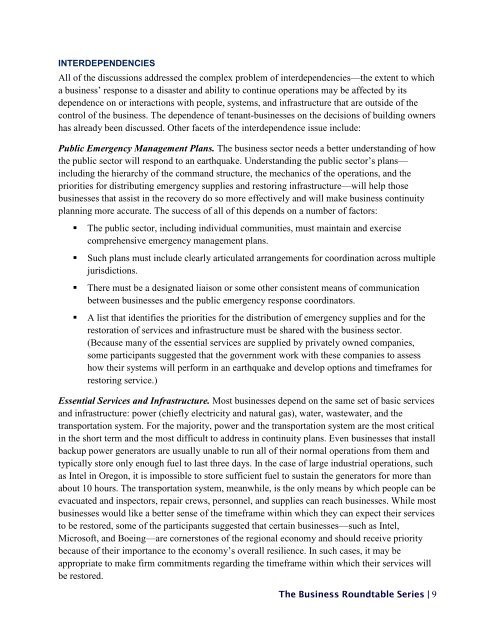Businesses in Cascadia - CREW
Businesses in Cascadia - CREW
Businesses in Cascadia - CREW
- No tags were found...
You also want an ePaper? Increase the reach of your titles
YUMPU automatically turns print PDFs into web optimized ePapers that Google loves.
INTERDEPENDENCIESAll of the discussions addressed the complex problem of <strong>in</strong>terdependencies—the extent to whicha bus<strong>in</strong>ess’ response to a disaster and ability to cont<strong>in</strong>ue operations may be affected by itsdependence on or <strong>in</strong>teractions with people, systems, and <strong>in</strong>frastructure that are outside of thecontrol of the bus<strong>in</strong>ess. The dependence of tenant-bus<strong>in</strong>esses on the decisions of build<strong>in</strong>g ownershas already been discussed. Other facets of the <strong>in</strong>terdependence issue <strong>in</strong>clude:Public Emergency Management Plans. The bus<strong>in</strong>ess sector needs a better understand<strong>in</strong>g of howthe public sector will respond to an earthquake. Understand<strong>in</strong>g the public sector’s plans—<strong>in</strong>clud<strong>in</strong>g the hierarchy of the command structure, the mechanics of the operations, and thepriorities for distribut<strong>in</strong>g emergency supplies and restor<strong>in</strong>g <strong>in</strong>frastructure—will help thosebus<strong>in</strong>esses that assist <strong>in</strong> the recovery do so more effectively and will make bus<strong>in</strong>ess cont<strong>in</strong>uityplann<strong>in</strong>g more accurate. The success of all of this depends on a number of factors:• The public sector, <strong>in</strong>clud<strong>in</strong>g <strong>in</strong>dividual communities, must ma<strong>in</strong>ta<strong>in</strong> and exercisecomprehensive emergency management plans.• Such plans must <strong>in</strong>clude clearly articulated arrangements for coord<strong>in</strong>ation across multiplejurisdictions.• There must be a designated liaison or some other consistent means of communicationbetween bus<strong>in</strong>esses and the public emergency response coord<strong>in</strong>ators.• A list that identifies the priorities for the distribution of emergency supplies and for therestoration of services and <strong>in</strong>frastructure must be shared with the bus<strong>in</strong>ess sector.(Because many of the essential services are supplied by privately owned companies,some participants suggested that the government work with these companies to assesshow their systems will perform <strong>in</strong> an earthquake and develop options and timeframes forrestor<strong>in</strong>g service.)Essential Services and Infrastructure. Most bus<strong>in</strong>esses depend on the same set of basic servicesand <strong>in</strong>frastructure: power (chiefly electricity and natural gas), water, wastewater, and thetransportation system. For the majority, power and the transportation system are the most critical<strong>in</strong> the short term and the most difficult to address <strong>in</strong> cont<strong>in</strong>uity plans. Even bus<strong>in</strong>esses that <strong>in</strong>stallbackup power generators are usually unable to run all of their normal operations from them andtypically store only enough fuel to last three days. In the case of large <strong>in</strong>dustrial operations, suchas Intel <strong>in</strong> Oregon, it is impossible to store sufficient fuel to susta<strong>in</strong> the generators for more thanabout 10 hours. The transportation system, meanwhile, is the only means by which people can beevacuated and <strong>in</strong>spectors, repair crews, personnel, and supplies can reach bus<strong>in</strong>esses. While mostbus<strong>in</strong>esses would like a better sense of the timeframe with<strong>in</strong> which they can expect their servicesto be restored, some of the participants suggested that certa<strong>in</strong> bus<strong>in</strong>esses—such as Intel,Microsoft, and Boe<strong>in</strong>g—are cornerstones of the regional economy and should receive prioritybecause of their importance to the economy’s overall resilience. In such cases, it may beappropriate to make firm commitments regard<strong>in</strong>g the timeframe with<strong>in</strong> which their services willbe restored.The Bus<strong>in</strong>ess Roundtable Series | 9




